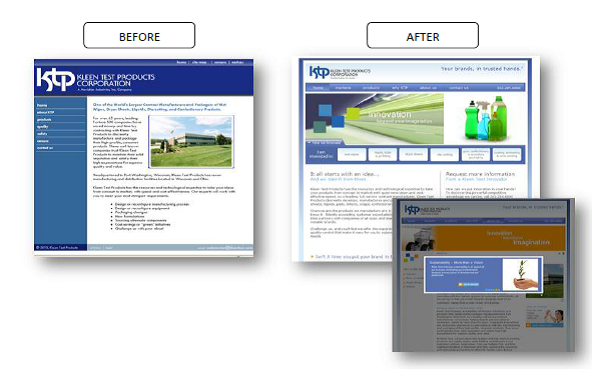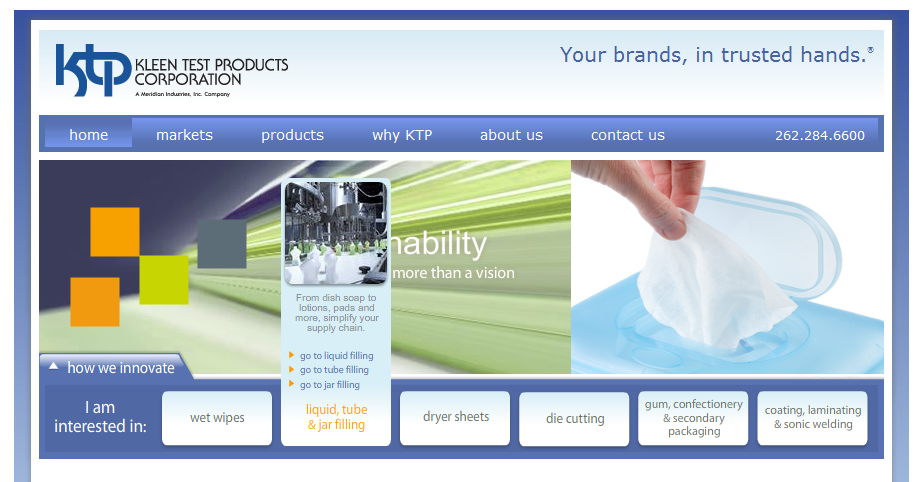For Kleen Test Products, the answer was a resounding “No.”
“Kleen who?” you ask. Chances are the products Kleen Test makes are in your home…you just don’t know it.
As one of the world’s largest contract manufacturers and packagers of wet wipes, dryer sheets, liquids, die cut pads, nutraceuticals and confectionery products, KTP is a long-time partner with companies of all sizes and many of the world’s most notable brands. Anyone who knows the company would agree that KTP is among the top US-based contract manufacturers in terms of innovation, quality, safety and capabilities. But for those not familiar with the company, one look at their website could cause doubt about its credibility and leave many top-of-mind questions unanswered. A complete website overhaul was the answer for Kleen Test and this month, the company launched its new online presence at www.KleenTest.com.

Getting “There” Means Following A Proven Website Development Process
Kleen Test Products, known for helping Fortune 500 companies save time and money by manufacturing their high-profile, consumer products, has a history of being discreet and confidential in their business processes. But to compete effectively against the many, many “me-to” players in the contract manufacturing arena, KTP found it couldn’t afford to plod along quietly. Here’s where they brought in Johnson Direct.
To adequately meet Kleen Test Product’s goals and objectives of increasing its visibility, credibility and leads via the web, Johnson Direct’s interactive team followed our proven four-phase process to strategize, concept, design and develop the new website.
- Phase One: Discovery, Research, Brainstorming and Planning
In our experience, this is the most overlooked phase in website development. Many businesses go from “We need a new website!” directly to the home page design without taking a hard look at where the company has been, what its competitors are up to, where the business is headed and how the website is going to help it achieve those goals.
Phase One deliverables include critical, must-have elements like the strategic project plan that will lay the foundation, a high level site map to organize and structure web pages in both a search engine and user-friendly manner, and a detailed content outline describing the logic behind content placement and development.
- Phase Two: Navigation, Wireframing, Design Concepts and Content Development
There are two navigation schemes that will help KTP visitors easily find and swiftly get to the information they’re specifically looking for. First, a roll-over primary navigation that allows them to get from the home page directly to an interior page of interest.
Second, an “I am interested in:” roll-over feature that divulges specific manufacturing capabilities by application. After all, when a prospect comes to the site, he or she will most likely have a specific application in mind. It also places a visual emphasis on all of those capabilities on the home page with appealing interactivity.

- Phase Three: Design, Production and Soft Launch
- Phase Four: Final Proofing, Testing and Hard Launch
The new site will not only greet prospects searching the world wide web for a reliable, credible contract manufacturer, but it will also serve as a handy sales tool for KTP’s network of sales representatives and customer service representatives. Kleen Test will debut the new website at this month’s World of Wipes Conference in Atlanta and the Health & Beauty Global Expo in New York.
8 Ways You Can Revamp Your Site to Meet Customers’ Needs
No doubt, you’ve visited plenty of websites that have proven to be a waste of your valuable time. If you’re like many business and marketing professionals, you secretly hope that your site meets the needs of your prospects, customers and internal users. But you’re not really sure, are you?
You can create a roadmap to greater website effectiveness by taking the following advice. You’ll find that the investment in time and money—to convert your site to a successful measurable marketing tool—well spent.
Here are several tips that promise both increased qualified traffic to your sites and enhanced visitor usability:
- Develop a marketing plan for your website. It’s not complicated, really! Focus your plan on your organization’s strengths, weaknesses, opportunities and threats, both online and off. Define your business, sales, marketing and online objectives. Create a detailed profile of your various website users. And, include the methods you’ll use to track and monitor the use and effectiveness of your site.
- While developing your website marketing plan, ask yourself “What is the purpose of my website?” Does it need to generate sales leads or requests for information? Is it an image-making tool? Or, rather, a customer service tool? Do your sales people use it to “sell” prospects on your capabilities? Once you’re really sure what it is you want your site to do, you can apply design and usability strategies to achieve specific objectives.
- Understand the users of your site. Your organization may need to communicate to a few different target markets and audiences. The more you know about each type of user (whether it’s an employee, customer or prospect), the better you can effectively communicate with him/her via your site.
- Make sure the strategy behind your website design comes from someone qualified. Often, businesses cut budget corners by asking the IT department to develop the site. Make sure your strategy and design efforts are in the hands of someone who understands the importance of usability. The investment now will eliminate the need for you to re-do your website again in the very near future.
- Don’t try something new because it looks “cool.” If you want to use multi-media or animation, ask yourself the reason why. What purpose will it serve? Will it help you to meet your goals? For example, if you’re making people sit through a flash program before they reach your home page, you may decide to scrap it! Businesspeople and consumers alike are pressed for time. Help them get the information they need quickly.
- Drive traffic to your site! Your site can and should be THE place you want people to go to get deeply involved with your company and to get to know your products and services. Make sure your URL is on your business cards, collateral material, your e-mail communications, and your advertisements. Simple, basic search engine optimization on your home page will help ensure qualified Internet users find your website through engines like Google, Yahoo and Ask. Basic search engine optimization can be achieved by incorporating well-written, search word-rich metatag title, description and keywords/phrases.
- Is your content fresh, or is it the same material you put up there when your site was first created? Give your visitors a reason to come back again and again.
- Monitor and measure your site. Proof and update content, make sure incoming e-mail is routed and answered promptly and test links and user tools (like your search function). Subscribe to a traffic analytics tool like Google Analytics, LiveStats or WebTrends. A traffic analytic tool will tell you how many visitors your site receives, where they are clicking within your site, how they found your site, what operating system and browser they are using, and much, much more. Use this valuable information to improve your site.
A successful website drives visitors to respond. Offers, surveys, e-newsletters, free white papers and other high value tactics encourage visitors to interact with the site. When developed with a strategic focus on direct response, websites and microsites will not only drive sales, but also gather information about customers and prospects, providing qualified leads for further sales and marketing efforts.
Of course, website design MUST revolve around the end user. Consider the needs of your customers, prospects, employees, the media and anyone else who might visit your site, in addition to your organizations business and marketing objectives. This approach is called “usability design” and it is necessary when creating intuitive navigation, easy-to-find content and useful response mechanisms.
Denise B. Hearden (denise.hearden@johnsondirect.com) is the Johnson Direct’s vice president of Interactive Services.






